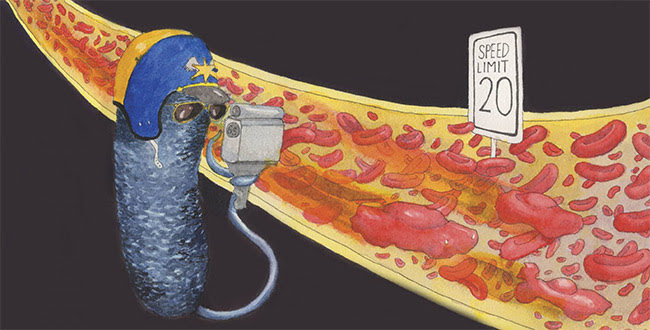
The faster the flow, the brighter the glow
Going with the flow is rarely a bad thing. Unless you’re talking about the notorious pathogen Pseudomonas. The bacterium is almost always surrounded by flowing water, and researchers are using part of that phenomenon to measure the flow of cells within the body.
They discovered that the pathogen detects flow and changes its behavior accordingly by activating genes that the Princeton-based researchers have dubbed “fro,” for “flow regulated operon.” They then used gene cloning to engineer a connection between fro and a yellow fluorescent protein that causes the bacterium to glow, said Joseph Sanfilippo, a lead author on the paper.

A team of Princeton University biologists and engineers led by Zemer Gitai bioengineered a real-time bacteria speedometer by linking a flow-detecting gene in Pseudomonas aeruginosa to one for illumination: The faster the flow, the brighter the glow. They discovered that flow detection occurs independent of force, prompting new questions about how bacteria sense their environments. Courtesy of Matilda Luk/Princeton University Office of Communications.
“Fro’s response is not just an on-off switch; it’s actually tuned to the speed,” Sanfilippo said. “It’s more like a dimmer switch than a light switch.”
The researchers viewed the bioluminescent response under a microscope, and what they saw was a real-time, visual speedometer. At slow shear rates (the rate at which adjacent layers of fluid pass by one another), the bioluminescence was dim. But at faster rates, the bacterium shone brightly.
What they perhaps didn’t expect was a significant revelation about the way the scientific community understands the biological perception of flow.
“Other researchers have found that different bacteria can respond to fluid flow, and they’ve effectively assumed that it [sensed] the force,” said professor Zemer Gitai, senior author on the paper. “The intuition was so strong that [the stimulus] should be force that, in fact, people didn’t bother to test this.”
Through experiments with fluids of varying viscosities, the researchers found that fro responded to shear rates between 40 and 400 per second. To put that into perspective, blood within an average-sized human vein flows at a shear rate of about 100 per second.
“The speeds that fro responds to are the speeds that are going through your body right now,” said Sanfilippo.
The revelation that some bacteria are able to measure and react to flow may open up new avenues for antibiotic treatments, especially for blood infections such as sepsis, said Joanne Engel, chief of infectious disease and professor of microbiology and
immunology at the University of California, San Francisco.
The research was published in Nature Microbiology www.nature.com/articles/s41564-019-0455-0.
Published: September 2019